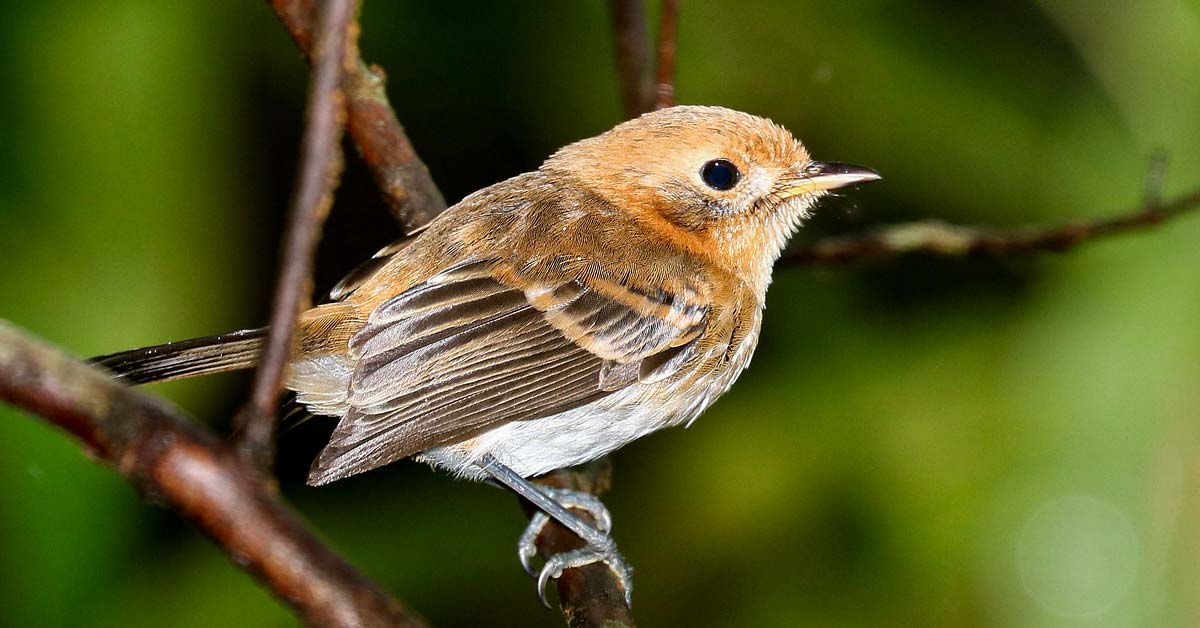Hawaii is blessed with many birds – some migrate to the island when other parts of the world get ice-cold, while others are native birds of Kauai and other smaller Hawaiian islands.
There used to be over a dozen native birds of Kauai. Due to various factors, this number has dropped to only 8.
If you’re new to birding, newly relocated to Kauai, or simply love birds of all feathers, this post should be an interesting one for you.
6 Native Birds of Kauai
Here are six native birds of Kauai. Hopefully, you will see them around the Garden Isle…
1. ‘Akeke’e (Loxops Caeruleirostris)
- Other names: Kaua‘i ‘akepa, Hawaiian Honeycreeper
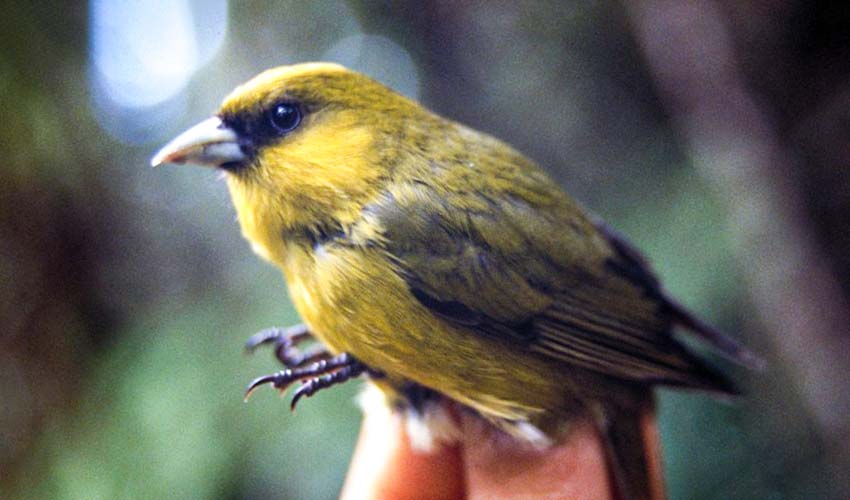
The ‘Akeke’e is a bird species in the family Fringillidae. It is endemic to the island of Kauaʻi where it is found in small numbers.
‘Akeke’e has been in the “critically endangered” list since 2010 with below 1000 of this type of honeycreeper bird left in the world.
Appearance: What does ‘Akeke’e look like?
‘Akeke’e are small, but eye-catchy thanks to their vibrant green and yellow plumage.
The plumage of adult males and females are greenish above and yellowish below, but females have a slightly duller color than males.
Both have yellow crowns, a distinct black mask and a notable asymmetric bluish bill (beak).
‘Akeke’e sound
Even to the ears of a professional birdwatcher, identifying ‘Akeke’es by ear is pretty challenging.
‘Akeke’es sound similar to several Kaua’i birds. They have soft, but extended vocalizations that aren’t like the typical subsongs of honeycreepers.
‘Akeke’e Habitat
These birds nest in high-elevation forests, making them hard to find.
If getting up close to an ‘Akeke’e is in your birdwatching bucket list, your best bet is to find them perched high on ‘ōhi’a trees at the eastern parts of either Koke’s State Park and the Alaka’i Wilderness Preserve.
2. ‘Akikiki (Oreomystis Bairdi)
- Other names: Kaua‘i creeper
‘Akikiki is another bird endemic to the island of Kauai. It is also considered the most endangered bird in the island with just less than 500 ‘Akikikis currently living in the wild.
In fact, as of 2021, only 45 ‘Akikiki has been recorded and spotted by people active with these birds’ conservation.
Appearance: What does ‘Akikiki look like?
Unlike other birds categorized as honeycreepers, ‘Akikikis do not have the vibrant yellow and red colors that Kauai honeycreepers are known for. Instead, ‘Akikikis are tiny, white and grayish honeycreepers.
Akikikis have olive to dark gray streaks on the head, sides, back and flanks, then a contrasting all-white to off-white plumage on their throats, bellies, breasts and under-tail coverts.
‘Akikiki sound
Like the ‘Akeke’e and other Kauai honeycreepers, ‘Akikikis are hard to identify by sound. They all sound the same – with their primary song characterized by a series of squeaks, cheeps, chips, and whinnies.
‘Akikiki Habitat
‘Akikikis breed from January to July, which is the best time to find them foraging food in pairs, socializing with other ‘Akikikis within their family group, or protecting their nests in the forest.
These birds build nests at an elevation above 3,700 feet. ‘Akikikis often stay in the forested Alaka’i area of Kauai and nest high in the crowns of ‘ōhi’a trees.
3. ‘Anianiau (Hemignathus Parvus)
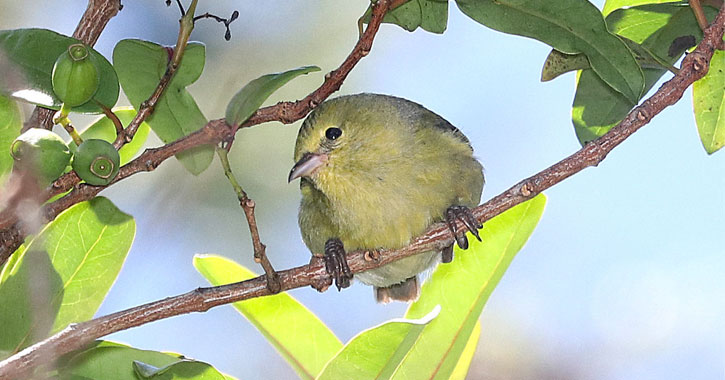
The ‘Anianiau is the smallest Hawaiian honeycreeper that is endemic to the island of Kauai. It is included in the group of endangered species alongside honeycreepers ‘Akikiki and ‘Akeke’e.
Appearance: What does ‘Anianiau look like?
Weighing only about 10 grams, the Anianiau is a tiny bird with bright greenish yellow plumage.
Males have golden yellow plumages with olive green wings and tail, a white belly and white undertail coverts.
Females are slightly duller in color, but are still in the yellow-green shade with gray and greenish plumage, white streaks and light yellow spots by the breast and head.
Both males and females have slightly curved, pinkish bills.
‘Anianiau sound
The call of a Anianiau sounds like a soft “suu-weeet,” while their songs consist of a series of “wisi-wisis.”
‘Anianiau Habitat
When Anianiau was first discovered, these birds fly all over the entire island of Kaua’i. But today, they are now restricted to the mountain ranges and build their nests above 600 meters in elevation.
You’d likely see Anianiaus in the forests of Waimea, Koke’e and Alaka’i regions. They breed from February to June, which is also the best time you can view these yellow birds.
4. Kaua’i ‘Amakihi (Chlorodrepanis Stejnegeri)
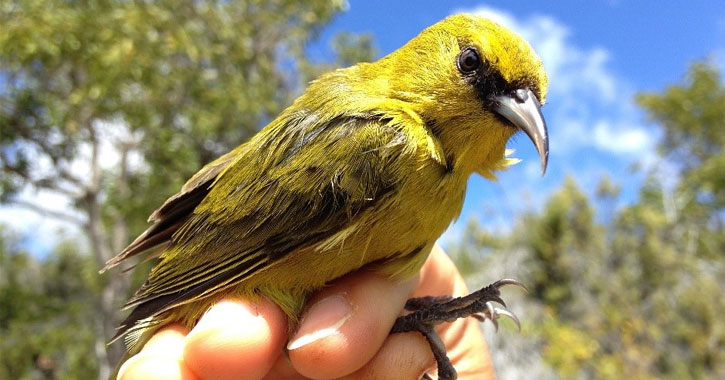
Kaua’i ‘Amakihi is a native Kauai bird and the largest Amakihi species within its family.
Although it isn’t an endangered species, less than 7,000 individuals exist within Kauai. Bird Life International categorized the Kauaʻi ʻamakihi as “vulnerable” because their populations are decreasing due to disease and habitat loss.
Appearance: What does Kaua’i ‘Amakihi look like?
The Kaua’i ‘Amakihi is a small olive green bird with a distinct downward-curving bill and black lores (the area between the beak and eyes).
Males and females have the same colors of plumage, but females have somewhat duller colors and smaller beaks.
Kaua’i ‘Amakihi sound
When flying or feeding, the Kaua’i ‘amakihi lets out a distinguishing tweet.
The call of Kaua’i ‘Amakihi is described as a nasal “cheeee” while its song is often a monotone trill that doesn’t change speed or pitch.
Kaua’i ‘Amakihi Habitat
Kaua’i ‘Amakihi used to roam around the entire Garden Isle, but these brightly-colored birds now just live exclusively in high elevation forests in the Alaka’i Wilderness and Koke’e region.
Many birders find Kaua’i ‘Amakihi while trekking the Pihea Vista and Alaka’i Swamp trails. They are known to be around ‘ōhi‘a and koa trees, where they often nest.
5. Kauai ‘Elepaio (Chasiempis sclateri)
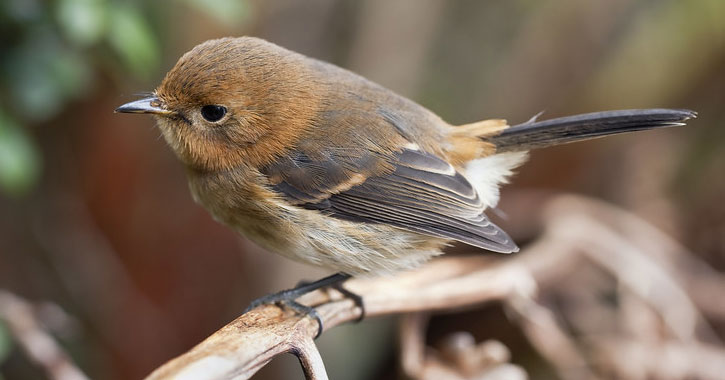
‘Elepaio is a flycatcher found in the Hawaiian islands of O’ahu and Kauai, but it is only endemic to Kauai.
For locals, the ‘Elepaio were believed to be the guiding spirit (‘aumakua) of canoe makers. They play an important role in Hawaii’s mythology.
Appearance: What does Kauai ‘Elepaio look like?
This small, grayish brown flycatcher weighs only about 12 to 18 grams.
Males and females have the same grayish brown head and back with orangey brown breast, as well as white underpants.
One notable characteristic of ‘Elepaio is their long tails, which commonly are help up at a certain angle.
Kauai ‘Elepaio sound
Males have a squeaky “el-ee-pai-o,” from which the bird’s name was derived.
Kauai ‘Elepaio Habitat
The ‘Elepaio used to thrive at all elevations, but are now restricted to forests above 1,000 m elevation in the Alaka’i Plateau. You can see these birds in mesic and rain forests in the Koke’e and Alaka’i regions on Kaua’i.
6. Puaihoi (Myadestes Palmeri)
- Other names: Small Kaua’i Thrush
Puaiohi is 1 of only 2 endemic Thrush species that still exist in Hawai’i today. Although, they are considered highly endangered with only below 500 individuals left.
These birds were first recorded in 1891 and has never been found beyond Kauai.
Appearance: What does Puaiohi look like?
Puaiohis are notable for their large size. They have grayish brown plumage with slaty-brown upperparts and light gray bellies and breasts.
Puaiohi sound
The song of a Puaiohi is varied and composed of many short notes ranging from a simple trill to high-pitched squeals.
Puaiohi Habitat
The Puaiohi used to inhabit forests down to sea level, but they now retreated to areas 1050 meters in elevation. These birds build nests in cavities or ledges of cliffs and are known to thrive in stream habitats.
Other Birds of Kauai
The six birds above are not the only ones you can see in Kauai. The ‘Apapane and ‘I’iwi are also native birds of Kauai.
Aside from these, dozens of other birds call Hawaii home (at least for awhile) when they migrate to this side of the country every season.
For other interesting bird info, check out:
